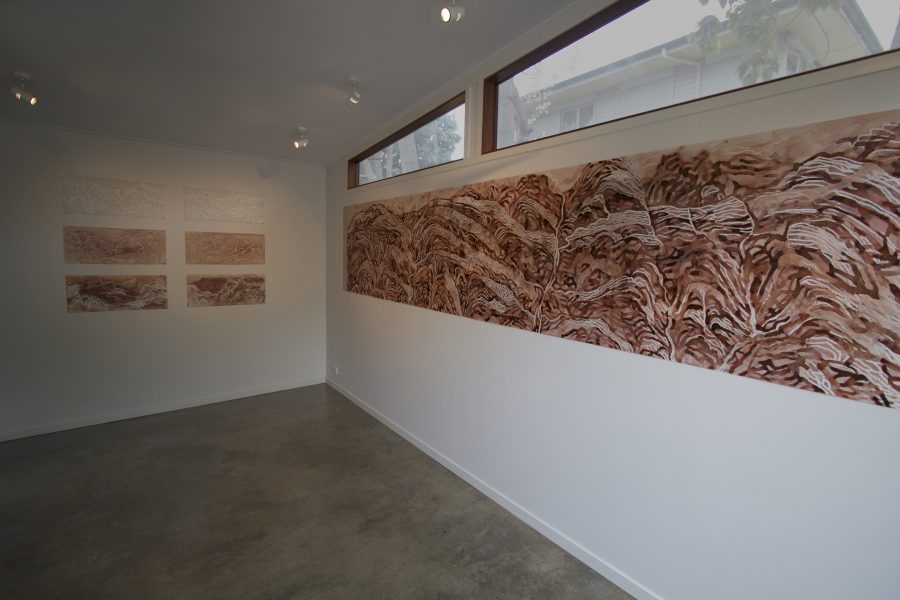In Ross’s studio, looking over finished works, works-in-progress and images of works being made and the most recent camp at Ross River, Central Australia, which led to this exhibition.
ROSS: This was the work when it started – that image underneath is actually a print-out four meters long of that google earth image, very pixelated, and then I’ve worked over the top. So it started with the fine line work and then this is gesso as well. The line work is Posca pens – they’re like acrylic paint in a pen. So that’s how the work started with that first layer of white. And then I started working on the back of it and kept working … there’s sand in there as well.
BETH: You’ve laid sand over it?
Sand and ink, giving it a texture.
And then you’ve removed that?
Removed the sand yes.
Nice.
Then I went over the whole thing with a very fine layer of ink that the gesso and the Posca absorbed and then I went over it again with the more fluid dark sepia lines.
The thing that’s striking for me is the lack of colour in these works. This seems to be a new concern as compared to your previous work. And so I was wondering about this sepia toning of the photographs and then these sepia pigments that you’re using – are you trying to access a more geological reading of the landscape rather than a seasonal or temporal reading?
Yes definitely. And also just getting back to drawing, more so than painting. So I see these as more like drawings even though they’re done with ink. The last exhibition that I had was the first time that I had started to use that palette and yes definitely more geological and less painterly.
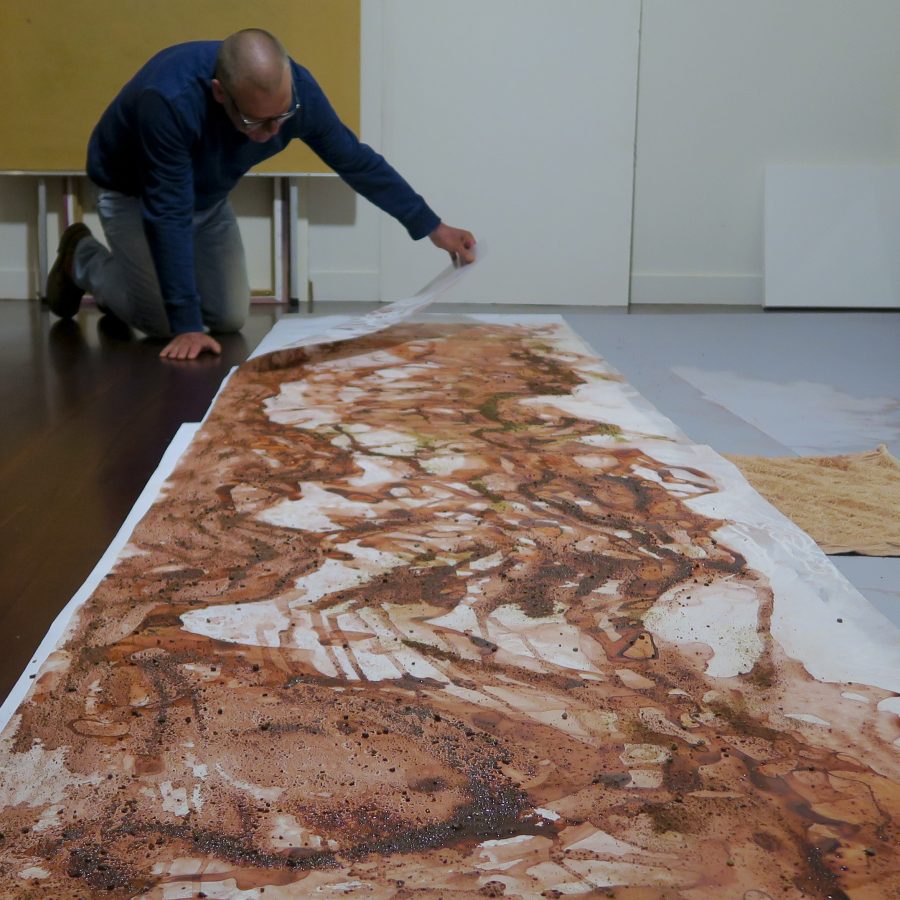
They’re very immersive works. Is that trying to reflect the experience of being in that place? Where the landscape takes you over?
Yes. For me, I find it difficult to be minimalist so my work tends to be overly busy. Sometimes it can work, sometimes it can get too busy but yes, if the viewer finds that experience immersive then I think that’s great. I suppose I’m not conscious of doing it for that reason.
How are you orienting these works as landscapes? Is the horizon very important?
The landform is really important, particularly in the smaller works. It’s reflective of that landscape that I experienced and have done for many, many years. There’s a particular landform of the MacDonnell Ranges which is really about the geological formations of all those ocean beds that have tilted up and then eroded away. You get very distinctive landforms within that range.
But the way you’re working with layering and this floating feeling – it’s almost the opposite of the big heavy earth, it’s almost perhaps a reflection of the heat coming off them – a dimensional experience of the phenomena of viewing. I guess that’s the essence of the tension you’re exploring between abstraction and representation?
The other thing I’ve done a fair bit of research into over the last couple of years is contemporary Chinese ink work because I think it’s just a natural gravitation to that from the directions I’m taking with the ink on drafting film which is like rice paper, and the layering, the way the Chinese layer their works. This of course is a step away again because it’s probably more abstract than the contemporary Chinese stuff, although some of the contemporary Chinese work is quite abstract.
If it’s linked to that calligraphic process then the actual making is a meditation as well isn’t it? Actually being in the artwork is coming out of the gesture and the body’s actions with the materials.
The gesture and the line. The line is the really important thing. Yes I think people would be able to see a fairly direct relationship with Chinese work.
But the line is also linked to your walking - the pathways in your mind of actually walking through these landscapes.
And there is also a link there to the Indigenous practice as well – you know the song lines.
Well that’s unavoidable isn’t it?
Yes probably because most of the time you’re walking through gorges or valleys where river courses have been that becomes a natural walking path. So Indigenous people would have walked the same walks that I’ve walked for thousands and thousands of years.
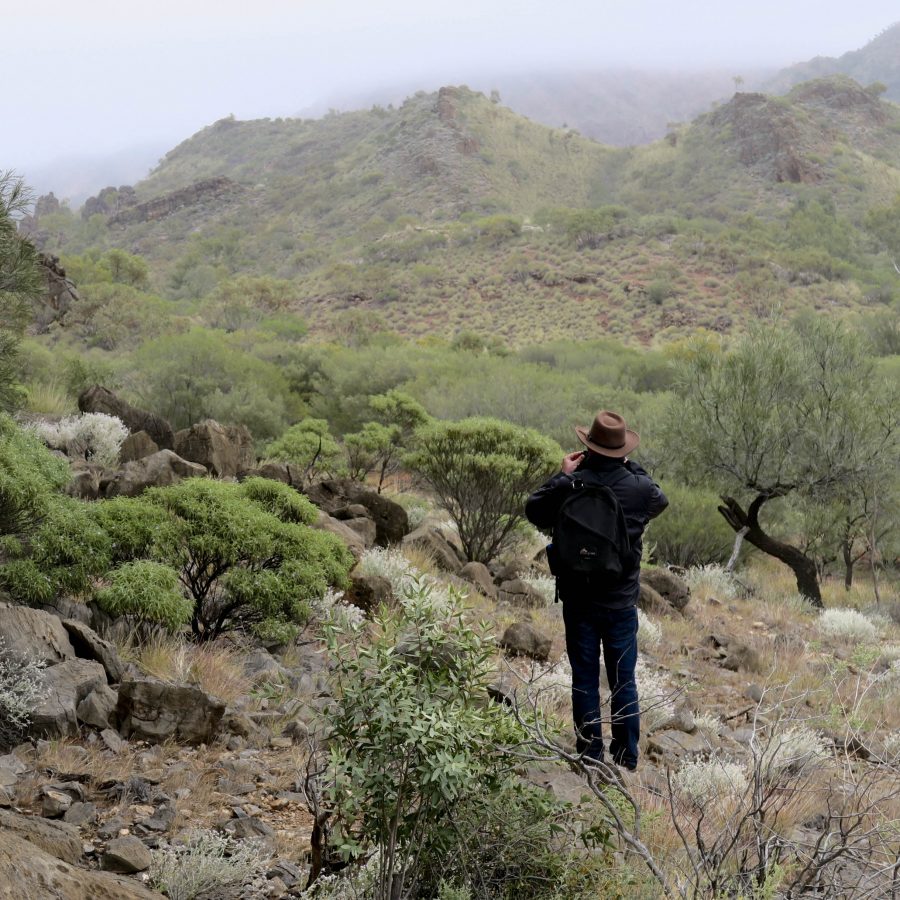
I was going to ask you what your method of walking was. Do you follow ridge lines? So you’re following water lines?
I’m doing climbing as well. Because to get the sort of views that orientate me in the landscape, I need to climb. So definitely climbing as well.
Yes because these works are a bit topsy turvy aren’t they – looking down and looking up and surrounded. They have that beautiful feeling of being all encompassing.
And because I work flat too, because it’s very liquid the media that I’m working on. Everything is worked on flat so I’m looking down on it when I’m working. So until I get it up on a wall it’s hard to know how the ‘weight’ of it works – but they do tend to float I think because of that fact because I’m working flat. I’m not working on a wall or on an incline.
And you’re not looking and working are you? You’re not working plein air?
When I’m walking I take a lot of photographs and draw sometimes. I didn’t do any sketchbook work this time around, but often I’ll take a sketchbook and draw fairly realistic sort of drawings. And then when I get back to camp that’s when I do the work. So the work’s not done out there, it’s done back at camp on a flat table.
So it’s still done in situ – and that’s important?
Yes because you’re immersed daily for two weeks. You’re in and out of the landscape and in and out of your painting or drawings.
And that transfer informs all the process …
Yep.
And there are no figures in the landscape. Is that because it would just anchor them with scale instantly?
I think it’s more about the abstract nature of them. I think a figure would just take it into another figurative realm and I just want to make sure that the abstract nature is really the thing that survives.
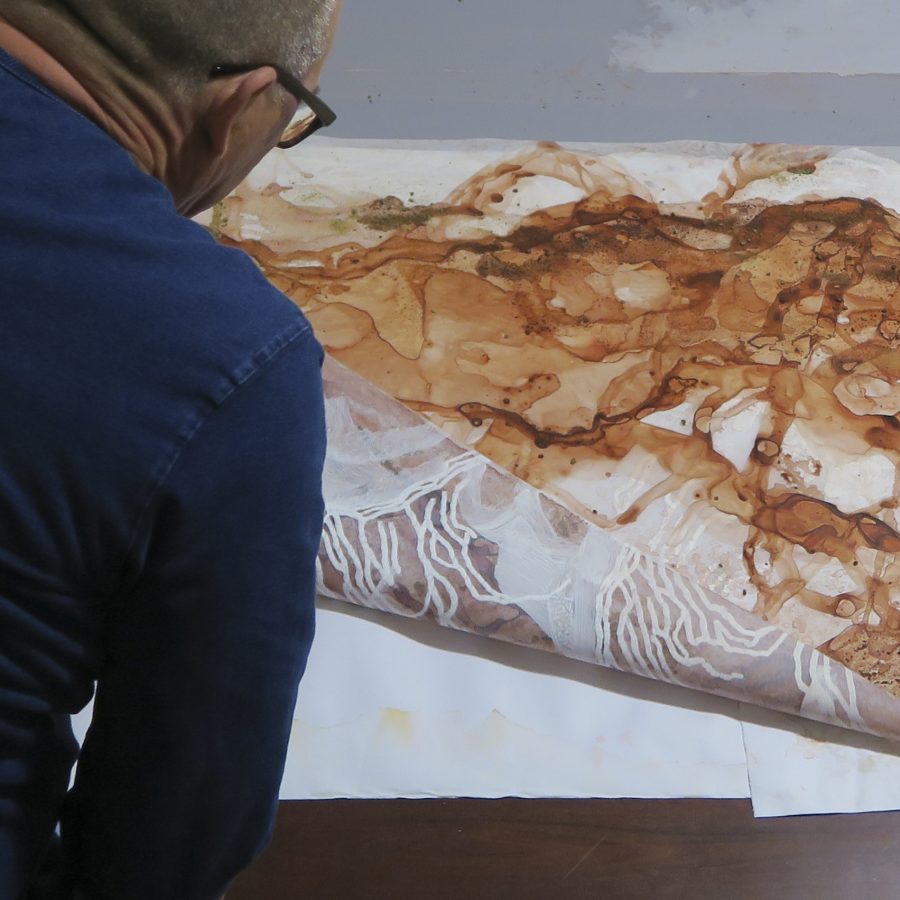
Is there a narrative in the work? A story? When you start and finish these works are you tracing some sort of story line in your head about what’s going on?
No, no real narrative. It’s more about a fascination with surface than anything. Surface and line. It’s that elemental. It’s really that traditional, I suppose, way of working in an abstract fashion which is primarily intuitive. Most of the time you’re trying to disconnect rather than connect. You’re trying to trick your mind into not controlling. Because the obvious tendency, particularly if you’ve done drawings in the landscape as well, is to refer back to very literal interpretations instead of more abstracted interpretations.
Can I ask, without meaning any offence at all, about your connection to this place when you’re obviously an urban person, a non-Indigenous person. Is art a way of authenticating your relationship with the landscape? What is this thing you have with central Australia and that many people I’m sure share?
Yes well it’s quite a thing. I’ve heard this so often since I’ve been out there – ‘the first time I went out there I felt like I’d come home’. The landscape I think is quite remarkable but there’s also a sense of place which people connect to.
In a primal way?
I don’t know if it’s primal or just very direct. And so many people will say ‘I’ve travelled everywhere through Australia. I love the Kimberleys. I love the Pilbara. I love certain landscapes. But there’s nothing like central Australia.’ And there’s those iconographic features like the Rock / Uluru and Kata Tjuta, and Kings Canyon, Watarrka, and all those places which are iconic in scale and their presence. But the MacDonnell Ranges has a different sort of presence – it just goes on and on for a start … It is remarkable and I think people’s connection with it is remarkable. So to go back to your original question I don’t think my work validates or strengthens my experience. The experience is so strong, it’s an automatic thing that being an artist that’s what I need to do and want to do.
To process that experience?
Yes. And going out there since 2008, that was my tenth trip, and each of those trips have been two weeks – so I’ve spent a fair bit of time out there. Not just in the MacDonnell ranges but around that central Australian landscape.
And there would be variation from year to year, depending on wet or dry etc.
Yes. There were a lot of flowers out this year because it’s been quite wet.
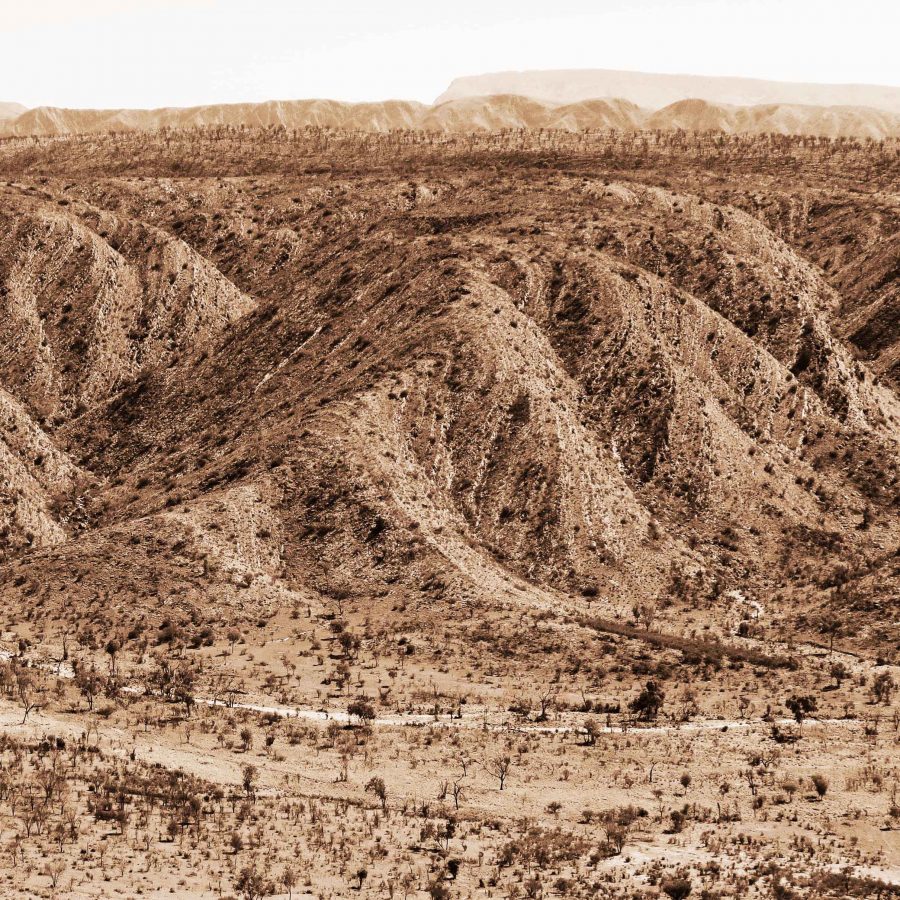
Is there an environmental story? Are you trying to make people aware of this landscape, as part of a message?
That’s probably a by-product more so than a focus. The fact is that people, when they’re immersed in my work, are obviously relating to the environment. It’s important that all those environmental concerns can be considered alongside my work, but it’s not a central focus for me.
And the recognition of central Australia in these works is important?
Not necessarily. If people have only been to the Kimberleys they may see the Kimberleys or the Pilbara. So that doesn’t concern me. It’s not so site-specific that I want people to see it and think that’s central Australia. I want people to see it and re-connect with the landscape in some way – whether they take the memory of my work into the landscape or they take the memory of the landscapes that they’ve seen into my work.
You mean in a meditative state, accessing deep time?
Well just relating to the work really.
But different to a photograph. Looking at art is different.
Oh yes. And it is like a meditation – one would hope that people do. Or contemplation is probably a better word.
Good art will always ask questions, invite the viewer to complete the piece, keep you inquiring into its form, won’t it? Rather than offering you information as such.
Yes. Hopefully my work’s not direct, it’s more intuitive, therefore hopefully my visual language is adding to the way that people look at and interpret art.
Art itself as well, not just the landscape, but that inter-relationship. Yes I think so too. It’s all evident in your work – its processes and so on. It’s evidential. Thanks Ross.
